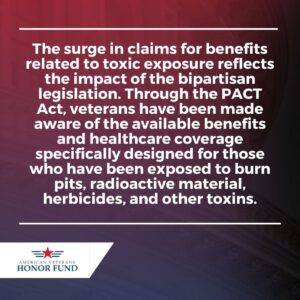In a significant development, the Department of Veterans Affairs (VA) revealed that half a million claims for benefits related to toxic exposure have been filed by veterans. This surge in claims follows the passage of the PACT Act last summer, which led to the largest expansion of VA coverage in a generation. With increased awareness about the long-term health effects of burn pits, radioactive materials, herbicides, and other toxins, the VA and veteran-service organizations have worked together to inform veterans about available benefits and healthcare coverage.
Recognizing the Effects of Toxic Exposure
The implementation of the PACT Act was driven by widespread criticism regarding the insufficient efforts made by the Department of Defense and the VA to address the effects of burn pits and other toxic exposures. Veterans, having endured exposure to these hazardous substances during their service, have faced significant health challenges. The bill aimed to rectify this situation by not only acknowledging the adverse consequences of toxic exposure but also allocating funds for research and treatment of affected individuals.

The surge in claims for benefits related to toxic exposure reflects the impact of the bipartisan legislation. Through the PACT Act, veterans have been made aware of the available benefits and healthcare coverage specifically designed for those who have been exposed to burn pits, radioactive material, herbicides, and other toxins. This expansion of coverage is a milestone in recognizing and addressing the health needs of veterans affected by toxic exposure.
Addressing the Research and Treatment Gap
Another crucial aspect of the PACT Act is its emphasis on funding research and treatment. By allocating resources to investigate the long-term effects of toxic exposure and develop effective treatment strategies, the bill aims to bridge the gap in understanding and addressing the health concerns of veterans. This research not only benefits current veterans but also contributes to the overall knowledge and well-being of future service members.
While the progress made through the toxic exposure bill is commendable, ongoing advocacy and support are crucial to ensure that veterans receive the necessary care and attention they deserve. The collaborative efforts of the VA, veteran-service organizations, and lawmakers play a vital role in disseminating information about benefits and healthcare coverage. Continued research, treatment advancements, and legislative support will further enhance the well-being of veterans affected by toxic exposure.


